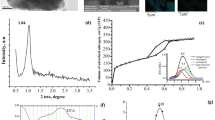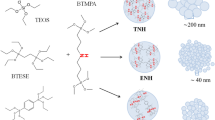Abstract
Sulfonate-functionalized nanoporous silica spheres (NSS-SO3) were prepared by conversion of epoxide to sulfonate with sulfonic acid salts. NSS-SO3 was used as an adsorbent for removal of methylene blue (MB) cationic dye. The adsorbent was characterized by means of scanning electron microscopy (SEM), N2 adsorption–desorption isotherms, Fourier-transform infrared (FTIR) and Raman spectroscopy, and thermogravimetric analysis. SEM images showed the spherical morphology of the material. The synthesized material was successfully applied for MB removal from synthetic solution in batch systems. The equilibrium sorption isotherm and kinetics were investigated. The adsorption of dye onto the adsorbent could reach equilibrium after 60 min. The equilibrium adsorption data were best described by the Langmuir isotherm. A maximum monolayer sorption capacity of 208 mg g−1 was found. The kinetic studies indicated that the adsorption process could be well fited by a pseudo-second-order kinetic model.












Similar content being viewed by others

References
B.E. Reed et al., Physicochemical processes. Water Environ. Res. 70(4), 449–473 (1998)
J. Lin et al., Fractionation of direct dyes and salts in aqueous solution using loose nanofiltration membranes. J. Membr. Sci. 477, 183–193 (2015)
B. Van der Bruggen et al., Mechanisms of retention and flux decline for the nanofiltration of dye baths from the textile industry. Sep. Purif. Technol. 22–23, 519–528 (2001)
S.P. Sun et al., Novel thin-film composite nanofiltration hollow fiber membranes with double repulsion for effective removal of emerging organic matters from water. J. Membr. Sci. 401–402, 152–162 (2012)
K. Dutta et al., Chemical oxidation of methylene blue using a Fenton-like reaction. J. Hazard. Mater. 84(1), 57–71 (2001)
M. Kornaros, G. Lyberatos, Biological treatment of wastewaters from a dye manufacturing company using a trickling filter. J. Hazard. Mater. 136(1), 95–102 (2006)
J.-W. Lee et al., Submerged microfiltration membrane coupled with alum coagulation/powdered activated carbon adsorption for complete decolorization of reactive dyes. Water Res. 40(3), 435–444 (2006)
C.-H. Liu et al., Removal of anionic reactive dyes from water using anion exchange membranes as adsorbers. Water Res. 41(7), 1491–1500 (2007)
M. Muruganandham, M. Swaminathan, TiO2–UV photocatalytic oxidation of reactive yellow 14: effect of operational parameters. J. Hazard. Mater. 135(1–3), 78–86 (2006)
A. Roy et al., Adsorption of anionic-azo dye from aqueous solution by lignocellulose-biomass jute fiber: equilibrium, kinetics, and thermodynamics study. Ind. Eng. Chem. Res. 51(37), 12095–12106 (2012)
D. Mahanta et al., Adsorption and desorption kinetics of anionic dyes on doped polyaniline. J. Phys. Chem. B 113(8), 2293–2299 (2009)
M. Li et al., Adsorption of hazardous dyes indigo carmine and acid red on nanofiber membranes. RSC Adv. 2(3), 900–907 (2012)
Y. Zhang et al., Cooperative adsorbent based on mesoporous SiO2 for organic pollutants in water. J. Mater. Chem. 21(43), 17283–17289 (2011)
B. Saha et al., Preferential and enhanced adsorption of different dyes on iron oxide nanoparticles: a comparative study. J. Phys. Chem. C 115(16), 8024–8033 (2011)
X.S. Wang et al., The removal of basic dyes from aqueous solutions using agricultural by-products. J. Hazard. Mater. 157(2–3), 374–385 (2008)
T. Robinson et al., Remediation of dyes in textile effluent: a critical review on current treatment technologies with a proposed alternative. Bioresour. Technol. 77(3), 247–255 (2001)
Z. Yan et al., Mesoporous silicas functionalized with a high density of carboxylate groups as efficient absorbents for the removal of basic dyestuffs. J. Mater. Chem. 16(24), 2347–2353 (2006)
W. Shi et al., High performance adsorbents based on hierarchically porous silica for purifying multicomponent wastewater. J. Mater. Chem. 21(39), 15567–15574 (2011)
Y. Ma et al., Large-pore mesoporous silica spheres: synthesis and application in HPLC. Colloids Surf. A 229(1–3), 1–8 (2003)
J.M. Rosenholm, A. Duchanoy, M. Lindén, Hyperbranching surface polymerization as a tool for preferential functionalization of the outer surface of mesoporous silica. Chem. Mater. 20(3), 1126–1133 (2008)
C.-H. Lee et al., Synthesis and characterization of positive-charge functionalized mesoporous silica nanoparticles for oral drug delivery of an anti-inflammatory drug. Adv. Funct. Mater. 18(20), 3283–3292 (2008)
Z. Bahrami, A. Badiei, F. Atyabi, Surface functionalization of SBA-15 nanorods for anticancer drug delivery. Chem. Eng. Res. Des. 92(7), 1296–1303 (2014)
T. Heikkilä et al., Mesoporous silica material TUD-1 as a drug delivery system. Int. J. Pharm. 331(1), 133–138 (2007)
Y. Hu et al., Facile synthesis of 3D cubic mesoporous silica microspheres with a controllable pore size and their application for improved delivery of a water-insoluble drug. J. Colloid Interface Sci. 363(1), 410–417 (2011)
G. Socrates, Infrared and Raman Characteristic Group Frequencies: Tables and Charts, 3rd edn. (Wiley, Hoboken, 2004)
S. Udayakumar et al., The complete optimization of ionic liquid-functionalized porous amorphous silica under one-pot synthesis conditions. Microporous Mesoporous Mater. 129(1–2), 149–155 (2010)
B. Riegel et al., Kinetic investigations of hydrolysis and condensation of the glycidoxypropyltrimethoxysilane/aminopropyltriethoxy-silane system by means of FT-Raman spectroscopy I. J. Non-Cryst. Solids 226(1–2), 76–84 (1998)
J.L. Bribes, M. El Boukari, J. Maillols, Application of Raman spectroscopy to industrial membranes. Part 2—perfluorosulphonic membrane. J. Raman Spectrosc. 22(5), 275–279 (1991)
W.J. Weber Jr, J.C. Morris, Kinetics of adsorption on carbon from solution. J. Sanit. Eng. Div. 89, 31–60 (1963)
L. Ai, C. Zhang, L. Meng, Adsorption of methyl orange from aqueous solution on hydrothermal synthesized Mg–Al layered double hydroxide. J. Chem. Eng. Data 56(11), 4217–4225 (2011)
C.-H. Huang et al., Adsorption of cationic dyes onto mesoporous silica. Microporous Mesoporous Mater. 141(1–3), 102–109 (2011)
M.M. Ayad, A.A. El-Nasr, Adsorption of cationic dye (methylene blue) from water using polyaniline nanotubes base. J. Phys. Chem. C 114(34), 14377–14383 (2010)
K.Y. Ho, G. McKay, K.L. Yeung, Selective adsorbents from ordered mesoporous silica. Langmuir 19(7), 3019–3024 (2003)
X. Fu et al., Fabrication of carboxylic functionalized superparamagnetic mesoporous silica microspheres and their application for removal basic dye pollutants from water. Microporous Mesoporous Mater. 139(1–3), 8–15 (2011)
G. McKay, Adsorption of dyestuffs from aqueous solutions with activated carbon I: equilibrium and batch contact-time studies. J. Chem. Technol. Biotechnol. 32(7–12), 759–772 (1982)
H.B. Senturk, D. Ozdes, C. Duran, Biosorption of rhodamine 6G from aqueous solutions onto almond shell (Prunus dulcis) as a low cost biosorbent. Desalination 252(1–3), 81–87 (2010)
Acknowledgments
We would like to express our gratitude to the Iran National Science Foundation (INSF) and the University of Tehran for supporting this work.
Author information
Authors and Affiliations
Corresponding author
Rights and permissions
About this article
Cite this article
Zarezadeh-Mehrizi, M., Badiei, A. & Shahbazi, A. Sulfonate-functionalized nanoporous silica spheres as adsorbent for methylene blue. Res Chem Intermed 42, 3537–3551 (2016). https://doi.org/10.1007/s11164-015-2230-z
Received:
Accepted:
Published:
Issue Date:
DOI: https://doi.org/10.1007/s11164-015-2230-z



